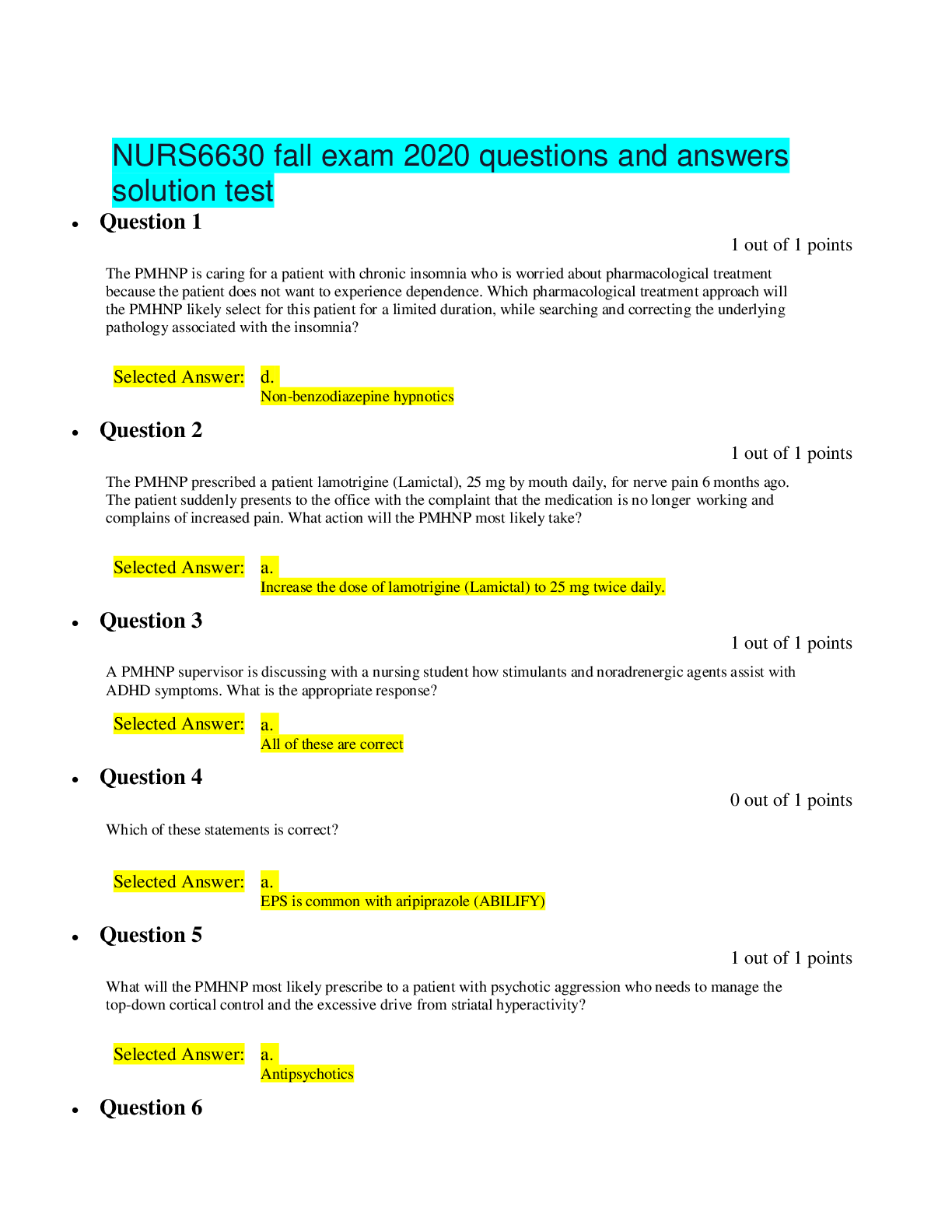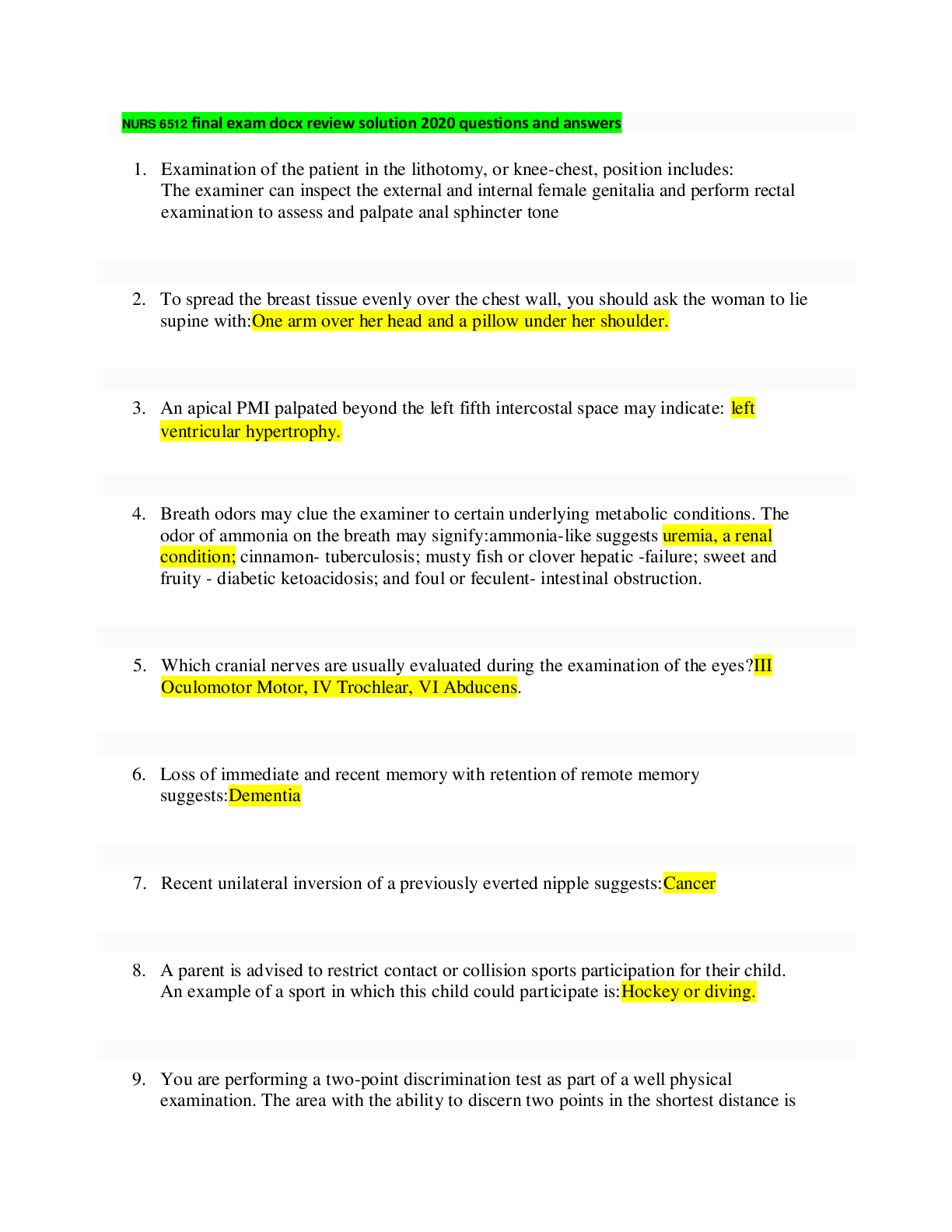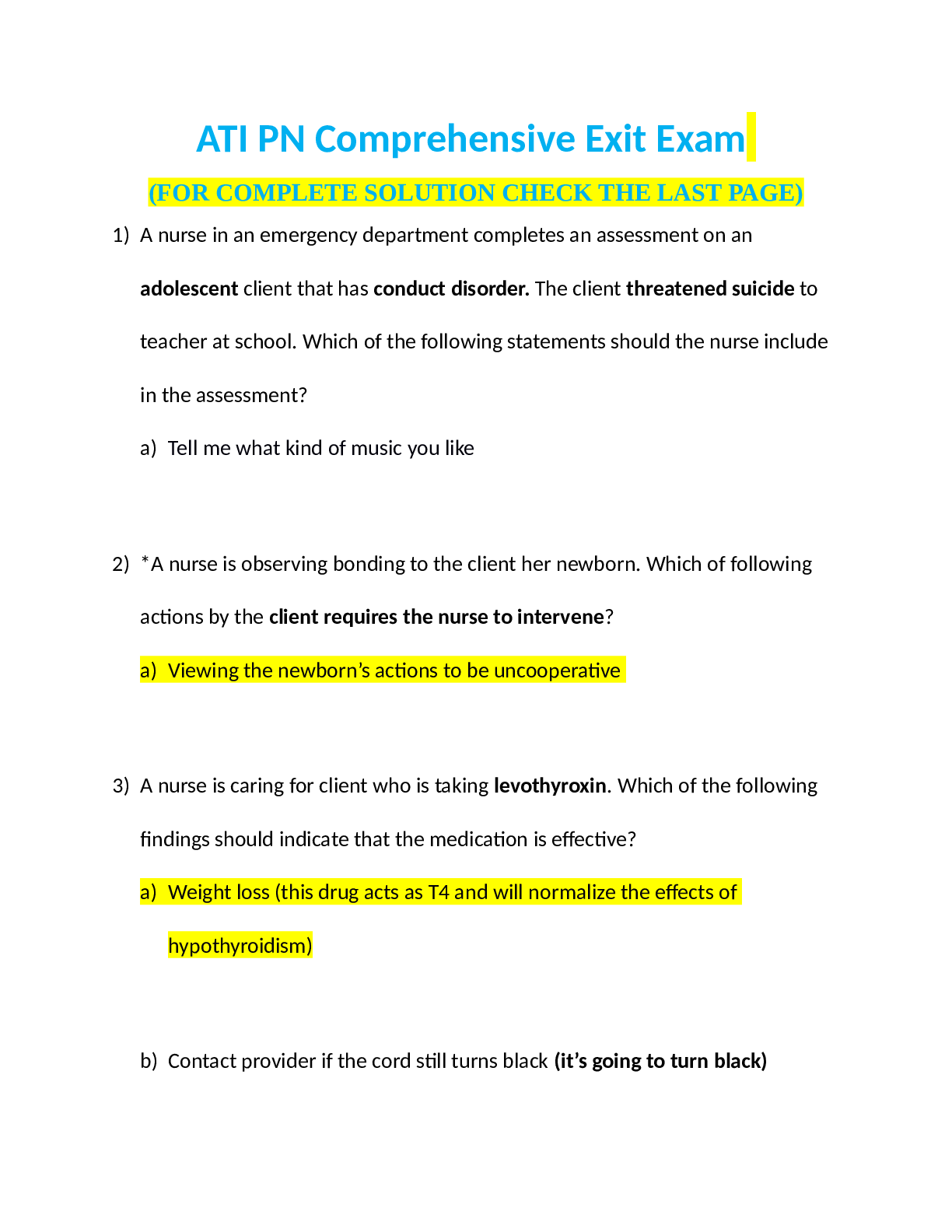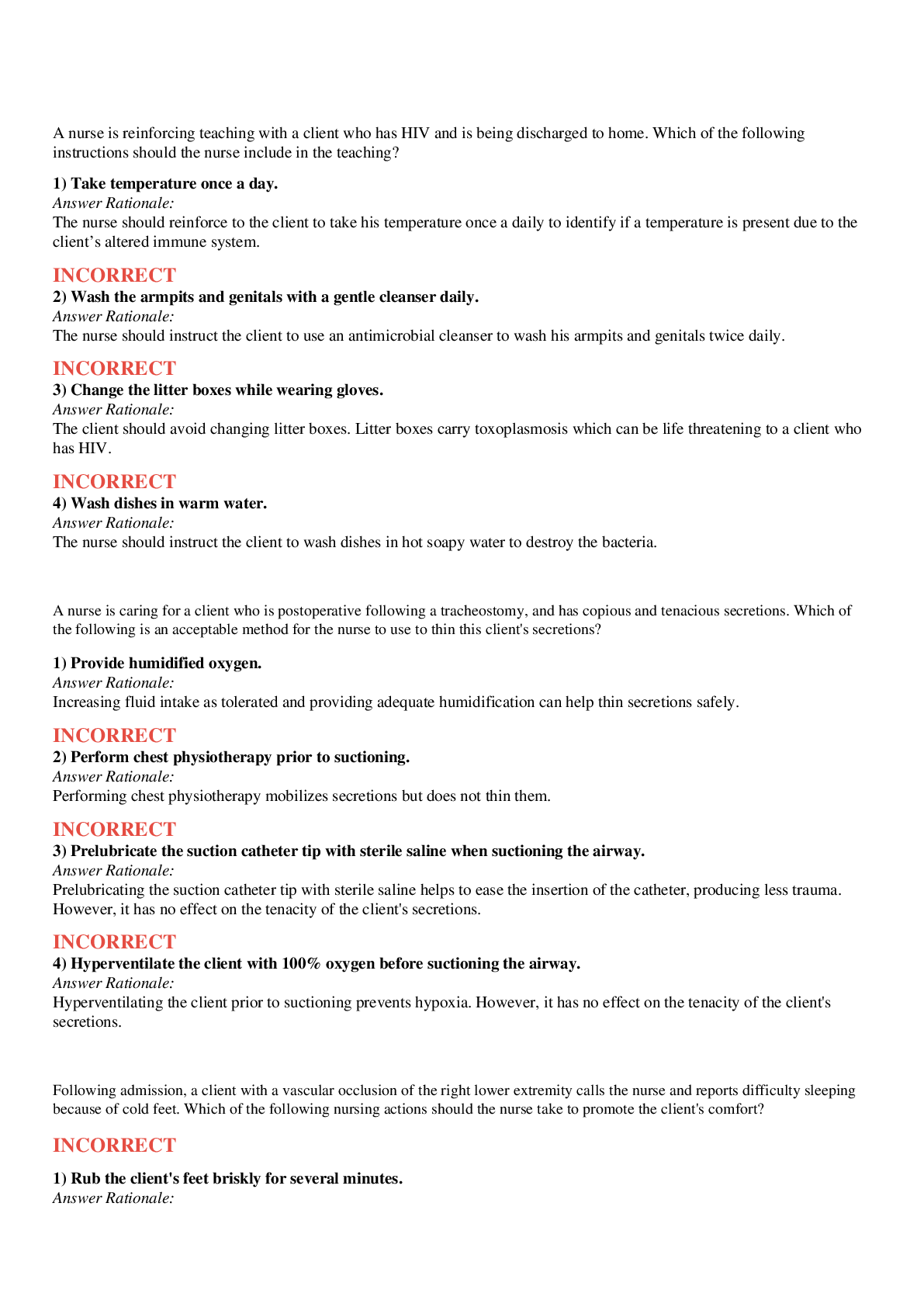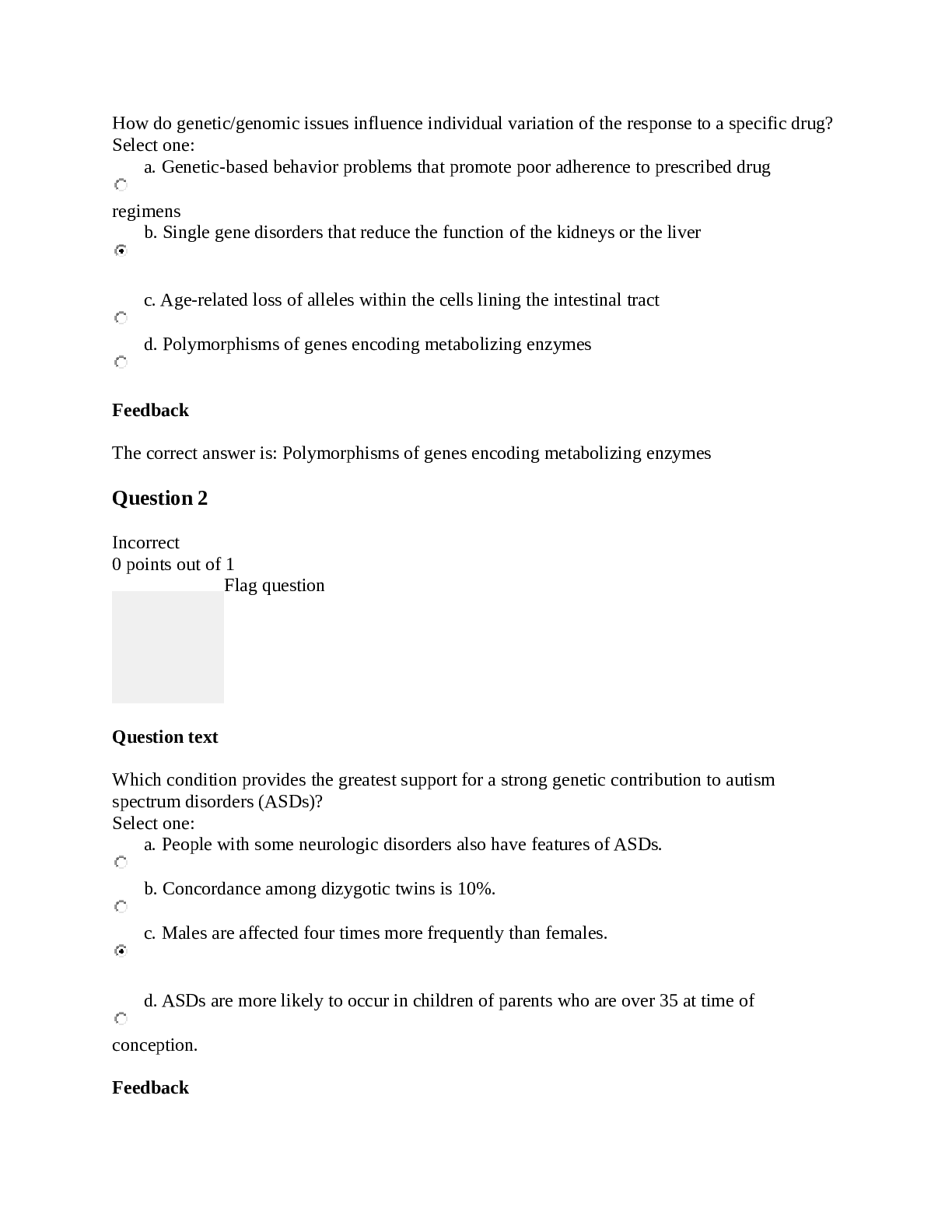Mathematics > QUESTIONS & ANSWERS > Introduction to Linear Programming . 20 Questions and Answers. 100% Correct. (All)
Introduction to Linear Programming . 20 Questions and Answers. 100% Correct.
Document Content and Description Below
7 Introduction to Linear Programming MULTIPLE CHOICE 1. The maximization or minimization of a quantity is the a. goal of management science. b. decision for decision analysis. c. constraint of o... perations research. d. objective of linear programming. TOPIC: Introduction 2. Decision variables a. tell how much or how many of something to produce, invest, purchase, hire, etc. b. represent the values of the constraints. c. measure the objective function. d. must exist for each constraint. TOPIC: Objective function 3. Which of the following is a valid objective function for a linear programming problem? a. Max 5xy b. Min 4x + 3y + (2/3)z c. Max 5x2 + 6y2 d. Min (x1 + x2)/x3 ASNWER: b TOPIC: Objective function 4. Which of the following statements is NOT true? a. A feasible solution satisfies all constraints. b. An optimal solution satisfies all constraints. c. An infeasible solution violates all constraints. d. A feasible solution point does not have to lie on the boundary of the feasible region. TOPIC: Graphical solution 12 Chapter 7 Introduction to Linear Programming 5. A solution that satisfies all the constraints of a linear programming problem except the nonnegativity constraints is called a. optimal. b. feasible. c. infeasible. d. semi-feasible. TOPIC: Graphical solution 6. Slack a. is the difference between the left and right sides of a constraint. b. is the amount by which the left side of a < constraint is smaller than the right side. c. is the amount by which the left side of a > constraint is larger than the right side. d. exists for each variable in a linear programming problem. TOPIC: Slack variables 7. To find the optimal solution to a linear programming problem using the graphical method a. find the feasible point that is the farthest away from the origin. b. find the feasible point that is at the highest location. c. find the feasible point that is closest to the origin. d. None of the alternatives is correct. TOPIC: Extreme points 8. Which of the following special cases does not require reformulation of the problem in order to obtain a solution? a. alternate optimality b. infeasibility c. unboundedness d. each case requires a reformulation. TOPIC: Special cases 9. The improvement in the value of the objective function per unit increase in a right-hand side is the a. sensitivity value. b. dual price. c. constraint coefficient. d. slack value. TOPIC: Right-hand sides 10. As long as the slope of the objective function stays between the slopes of the binding constraints a. the value of the objective function won’t change. b. there will be alternative optimal solutions. c. the values of the dual variables won’t change. d. there will be no slack in the solution. TOPIC: Objective function 11. Infeasibility means that the number of solutions to the linear programming models that satisfies all constraints is a. at least 1. b. 0.Chapter 7 Introduction to Linear Programming 3 c. an infinite number. d. at least 2. TOPIC: Alternate Optimal Solution 12. A constraint that does not affect the feasible region is a a. non-negativity constraint. b. redundant constraint. c. standard constraint. d. slack constraint. TOPIC: Feasible regions 13. Whenever all the constraints in a linear program are expressed as equalities, the linear program is said to be written in a. standard form. b. bounded form. c. feasible form. d. alternative form. TOPIC: Slack variables 14. All of the following statements about a redundant constraint are correct EXCEPT a. A redundant constraint does not affect the optimal solution. b. A redundant constraint does not affect the feasible region. c. Recognizing a redundant constraint is easy with the graphical solution method. d. At the optimal solution, a redundant constraint will have zero slack. TOPIC: Slack variables 15. All linear programming problems have all of the following properties EXCEPT a. a linear objective function that is to be maximized or minimized. b. a set of linear constraints. c. alternative optimal solutions. d. variables that are all restricted to nonnegative values. TOPIC: Problem formulation TRUE/FALSE 1. Increasing the right-hand side of a nonbinding constraint will not cause a change in the optimal solution. ANSWER: False TOPIC: Introduction 2. In a linear programming problem, the objective function and the constraints must be linear functions of the decision variables. ANSWER: True TOPIC: Mathematical statement of the RMC Problem 3. In a feasible problem, an equal-to constraint cannot be nonbinding.4 Chapter 7 Introduction to Linear Programming ANSWER: True TOPIC: Graphical solution 4. Only binding constraints form the shape (boundaries) of the feasible region. ANSWER: False TOPIC: Graphical solution 5. The constraint 5x1 - 2x2 < 0 passes through the point (20, 50). ANSWER: True TOPIC: Graphing lines 6. A redundant constraint is a binding constraint. ANSWER: False TOPIC: Slack variables 7. Because surplus variables represent the amount by which the solution exceeds a minimum target, they are given positive coefficients in the objective function. ANSWER: False TOPIC: Slack variables 8. Alternative optimal solutions occur when there is no feasible solution to the problem. ANSWER: False TOPIC: Alternative optimal solutions 9. A range of optimality is applicable only if the other coefficient remains at its original value. ANSWER: True TOPIC: Simultaneous changes 10. Because the dual price represents the improvement in the value of the optimal solution per unit increase in right-hand-side, a dual price cannot be negative. ANSWER: False TOPIC: Right-hand sides 11. Decision variables limit the degree to which the objective in a linear programming problem is satisfied. ANSWER: False TOPIC: Introduction 12. No matter what value it has, each objective function line is parallel to every other objective function line in a problem. ANSWER: True TOPIC: Graphical solution 13. The point (3, 2) is feasible for the constraint 2x1 + 6x2 30. ANSWER: True TOPIC: Graphical solution 14. The constraint 2x1 - x2 = 0 passes through the point (200,100). ANSWER: False TOPIC: A note on graphing lines 15. The standard form of a linear programming problem will have the same solution as the original problem. ANSWER: True TOPIC: Surplus variables 16. An optimal solution to a linear programming problem can be found at an extreme point of the feasible region for the problem. ANSWER: TrueChapter 7 Introduction to Linear Programming 5 TOPIC: Extreme Points 17. An unbounded feasible region might not result in an unbounded solution for a minimization or maximization problem. ANSWER: True TOPIC: Special cases: unbounded 18. An infeasible problem is one in which the objective function can be increased to infinity. ANSWER: False TOPIC: Special cases: infeasibility 19. A linear programming problem can be both unbounded and infeasible. ANSWER: False TOPIC: Special cases: infeasibility and unbounded 20. It is possible to have exactly two optimal solutions to a linear programming problem. ANSWER: False TOPIC: Special cases: alternative optimal solutions SHORT ANSWER 1. Explain the difference between profit and contribution in an objective function. Why is it important for the decision maker to know which of these the objective function coefficients represent? TOPIC: Objective function 2. Explain how to graph the line x1 - 2x2 > 0. TOPIC: Graphing lines 3. Create a linear programming problem with two decision variables and three constraints that will include both a slack and a surplus variable in standard form. Write your problem in standard form. TOPIC: Standard form 4. Explain what to look for in problems that are infeasible or unbounded. TOPIC: Special cases 5. Use a graph to illustrate why a change in an objective function coefficient does not necessarily lead to a change in the optimal values of the decision variables, but a change in the right-hand sides of a binding constraint does lead to new values. TOPIC: Graphical sensitivity analysis 6. Explain the concepts of proportionality, additivity, and divisibility. TOPIC: Notes and comments PROBLEMS 1. Solve the following system of simultaneous equations. 6X + 2Y = 50 2X + 4Y = 206 Chapter 7 Introduction to Linear Programming TOPIC: Simultaneous equations 1. X = 8, Y = 1 b. The optimal solution occurs at the intersection of constraints 2 and 3. The point is X = 3, Y = 5. c. The value of the objective function is 59. 2. Solve the following system of simultaneous equations. 6X + 4Y = 40 2X + 3Y = 20 TOPIC: Simultaneous equations 2. X = 4, Y = 4 3. Consider the following linear programming problem a. Use a graph to show each constraint and the feasible region. b. Identify the optimal solution point on your graph. What are the values of X and Y at the optimal solution? c. What is the optimal value of the objective function? TOPIC: Graphical solution 4. For the following linear programming problem, determine the optimal solution by the graphical solution method Max X + 2Y s.t. 6X – 2Y 3 2X + 3Y 6 X + Y 3Chapter 7 Introduction to Linear Programming 7 X, Y 0 TOPIC: Graphical solution 4. X = 0.6 and Y = 2.4 Feasible Region 5. Use this graph to answer the questions. Max 20X + 10Y s.t. 12X + 15Y < 180 15X + 10Y < 150 3X - 8Y < 0 X , Y > 08 Chapter 7 Introduction to Linear Programming a. Which area (I, II, III, IV, or V) forms the feasible region? b. Which point (A, B, C, D, or E) is optimal? c. Which constraints are binding? d. Which slack variables are zero? TOPIC: Graphical solution 5. a. Area III is the feasible region b. Point D is optimal c. Constraints 2 and 3 are binding d. S2 and S3 are equal to 0 6. Find the complete optimal solution to this linear programming problem. Min 5X + 6Y TOPIC: Graphical solution 6. 5 Feasible Region The complete optimal solution is X = 6, Y = 3, Z = 48, S1 = 6, S2 = 0, S3 = 0 7. Find the complete optimal solution to this linear programming problem. Max 5X + 3Y s.t. 2X + 3Y < 30 2X + 5Y < 40 6X - 5Y < 0 X , Y > 0 TOPIC: Graphical solutionChapter 7 Introduction to Linear Programming 9 7. The complete optimal solution is X = 15, Y = 0, Z = 75, S1 = 0, S2 = 10, S3 = 90 8. Find the complete optimal solution to this linear programming problem. Max 2X + 3Y TOPIC: Graphical solution 8.10 Chapter 7 Introduction to Linear Programming The complete optimal solution is X = 4.304, Y = 6.087, Z = 26.87, S1 = 0, S2 = 0, S3 = 25.043 9. Find the complete optimal solution to this linear programming problem. TOPIC: Graphical solutionChapter 7 Introduction to Linear Programming 11 9. The complete optimal solution is X = 4, Y = 2, Z = 18, S1 = 8, S2 = 0, S3 = 0 10. For the following linear programming problem, determine the optimal solution by the graphical solution method. Are any of the constraints redundant? If yes, then identify the constraint that is redundant. TOPIC: Graphical solution 10. X = 2, and Y = 1 Yes, there is a redundant constraint; Y 112 Chapter 7 Introduction to Linear Programming 3 2 1 0 0 1 2 3 Feasible Region 11. Maxwell Manufacturing makes two models of felt tip marking pens. Requirements for each lot of pens are given below. Fliptop Model Tiptop Model Available Plastic 3 4 36 Ink Assembly 5 4 40 Molding Time 5 2 30 The profit for either model is $1000 per lot. a. What is the linear programming model for this problem? b. Find the optimal solution. c. Will there be excess capacity in any resource? TOPIC: Modeling and graphical solution 11. a. Let F = the number of lots of Fliptip pens to produce Let T = the number of lots of Tiptop pens to produce Max 1000F + 1000T s.t. 3F + 4T < 36 b.Chapter 7 Introduction to Linear Programming 13 The complete optimal solution is F = 2, T = 7.5, Z = 9500, S1 = 0, S2 = 0, S3 = 5 c. There is an excess of 5 units of molding time available. 12. The Sanders Garden Shop mixes two types of grass seed into a blend. Each type of grass has been rated (per pound) according to its shade tolerance, ability to stand up to traffic, and drought resistance, as shown in the table. Type A seed costs $1 and Type B seed costs $2. If the blend needs to score at least 300 points for shade tolerance, 400 points for traffic resistance, and 750 points for drought resistance, how many pounds of each seed should be in the blend? Which targets will be exceeded? How much will the blend cost? Type A Type B Shade Tolerance 1 1 Traffic Resistance 2 1 Drought Resistance 2 5 TOPIC: Modeling and graphical solution 12. Let A = the pounds of Type A seed in the blend Let B = the pounds of Type B seed in the blend Min 1A + 2B s.t. 1A + 1B 300 2A + 1B 400 2A + 5B 750 A, B 014 Chapter 7 Introduction to Linear Programming 0 0 100 200 300 400 The optimal solution is at A = 250, B = 50. Constraint 2 has a surplus value of 150. The cost is 350. 13. Muir Manufacturing produces two popular grades of commercial carpeting among its many other products. In the coming production period, Muir needs to decide how many rolls of each grade should be produced in order to maximize profit. Each roll of Grade X carpet uses 50 units of synthetic fiber, requires 25 hours of production time, and needs 20 units of foam backing. Each roll of Grade Y carpet uses 40 units of synthetic fiber, requires 28 hours of production time, and needs 15 units of foam backing. The profit per roll of Grade X carpet is $200 and the profit per roll of Grade Y carpet is $160. In the coming production period, Muir has 3000 units of synthetic fiber available for use. Workers have been scheduled to provide at least 1800 hours of production time (overtime is a possibility). The company has 1500 units of foam backing available for use. Develop and solve a linear programming model for this problem. TOPIC: Modeling and graphical solution 13. Let X = the number of rolls of Grade X carpet to make Let Y = the number of rolls of Grade Y carpet to make Max 200X + 160Y s.t. 50X + 40Y 3000 25X + 28Y > 1800 20X + 15Y 1500 X , Y > 0Chapter 7 Introduction to Linear Programming 15 0 10 20 30 40 50 60 70 80 90 100 F. R. The complete optimal solution is X = 30, Y = 37.5, Z = 12000, S1 = 0, S2 = 0, S3 = 337.5 14. Does the following linear programming problem exhibit infeasibility, unboundedness, or alternate optimal solutions? Explain. Min 1X + 1Y TOPIC: Special cases 14. The problem is infeasible. 0 5 10 1516 Chapter 7 Introduction to Linear Programming 15. Does the following linear programming problem exhibit infeasibility, unboundedness, or alternate optimal solutions? Explain. Min 3X + 3Y TOPIC: Special cases 15. The problem has alternate optimal solutions. 16. A businessman is considering opening a small specialized trucking firm. To make the firm profitable, it is estimated that it must have a daily trucking capacity of at least 84,000 cu. ft. Two types of trucks are appropriate for the specialized operation. Their characteristics and costs are summarized in the table below. Note that truck 2 requires 3 drivers for long haul trips. There are 41 potential drivers available and there are facilities for at most 40 trucks. The businessman's objective is to minimize the total cost outlay for trucks. Capacity Drivers Truck Cost (Cu. Ft.) Needed Small $18,000 2,400 1 Large $45,000 6,000 3 Solve the problem graphically and note there are alternate optimal solutions. Which optimal solution: a. uses only one type of truck? b. utilizes the minimum total number of trucks? c. uses the same number of small and large trucks? TOPIC: Alternative optimal solutions 16. a. 35 small, 0 large b. 5 small, 12 large c. 10 small, 10 large 17. Consider the following linear program:Chapter 7 Introduction to Linear Programming 17 MAX 60X + 43Y a. Write the problem in standard form. b. What is the feasible region for the problem? c. Show that regardless of the values of the actual objective function coefficients, the optimal solution will occur at one of two points. Solve for these points and then determine which one maximizes the current objective function. TOPIC: Standard form and extreme points 17. a. MAX 60X + 43Y b. Line segment of 6X – 2Y = 12 between (22/7,24/7) and (27/10,21/10). c. Extreme points: (22/7,24/7) and (27/10,21/10). First one is optimal, giving Z = 336. 18. Solve the following linear program graphically. TOPIC: Graphical solution procedure 18. From the graph below we see that the optimal solution occurs at X = 5, Y = 3, and Z = 46. Optimal X = 5, Y = 3 Z = 46 19. Given the following linear program: MIN 150X + 210Y18 Chapter 7 Introduction to Linear Programming Solve the problem graphically. How many extreme points exist for this problem? 19. Two extreme points exist (Points A and B below). The optimal solution is X = 10, Y = 6, and Z = 2760 (Point B). TOPIC: Graphical solution procedure 20. Solve the following linear program by the graphical method. MAX 4X + 5Y s.t. X + 3Y < 22 -X + Y < 4 Y < 6 2X - 5Y < 0 X, Y > 0 TOPIC: Graphical solution procedure 20. Two extreme points exist (Points A and B below). The optimal solution is X = 10, Y = 6, and Z = 2760 (Point B).Chapter 7 Introduction to Linear Programming 19 [Show More]
Last updated: 1 year ago
Preview 1 out of 19 pages
.png)
Buy this document to get the full access instantly
Instant Download Access after purchase
Add to cartInstant download
We Accept:

Reviews( 0 )
$14.00
Document information
Connected school, study & course
About the document
Uploaded On
Mar 31, 2021
Number of pages
19
Written in
Additional information
This document has been written for:
Uploaded
Mar 31, 2021
Downloads
0
Views
53

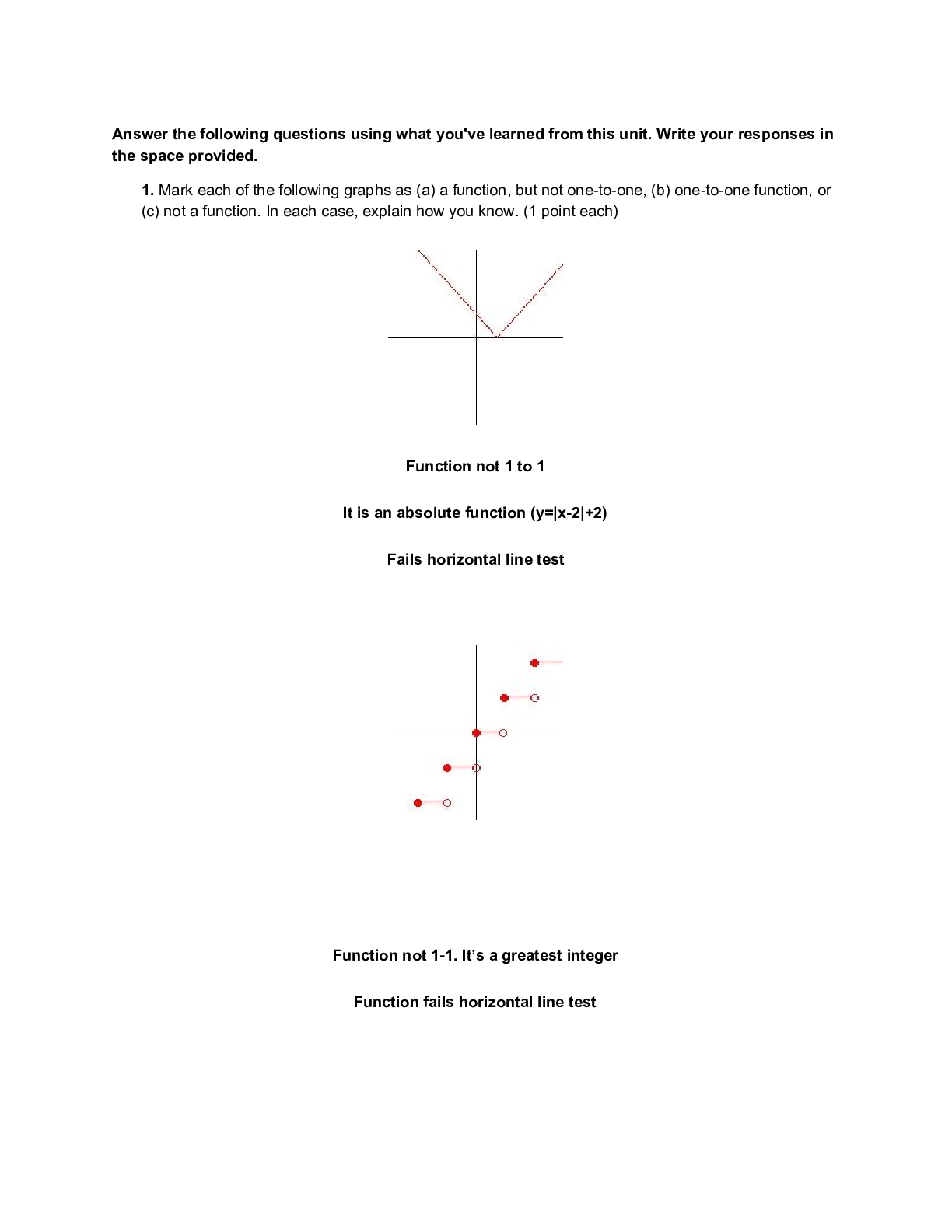
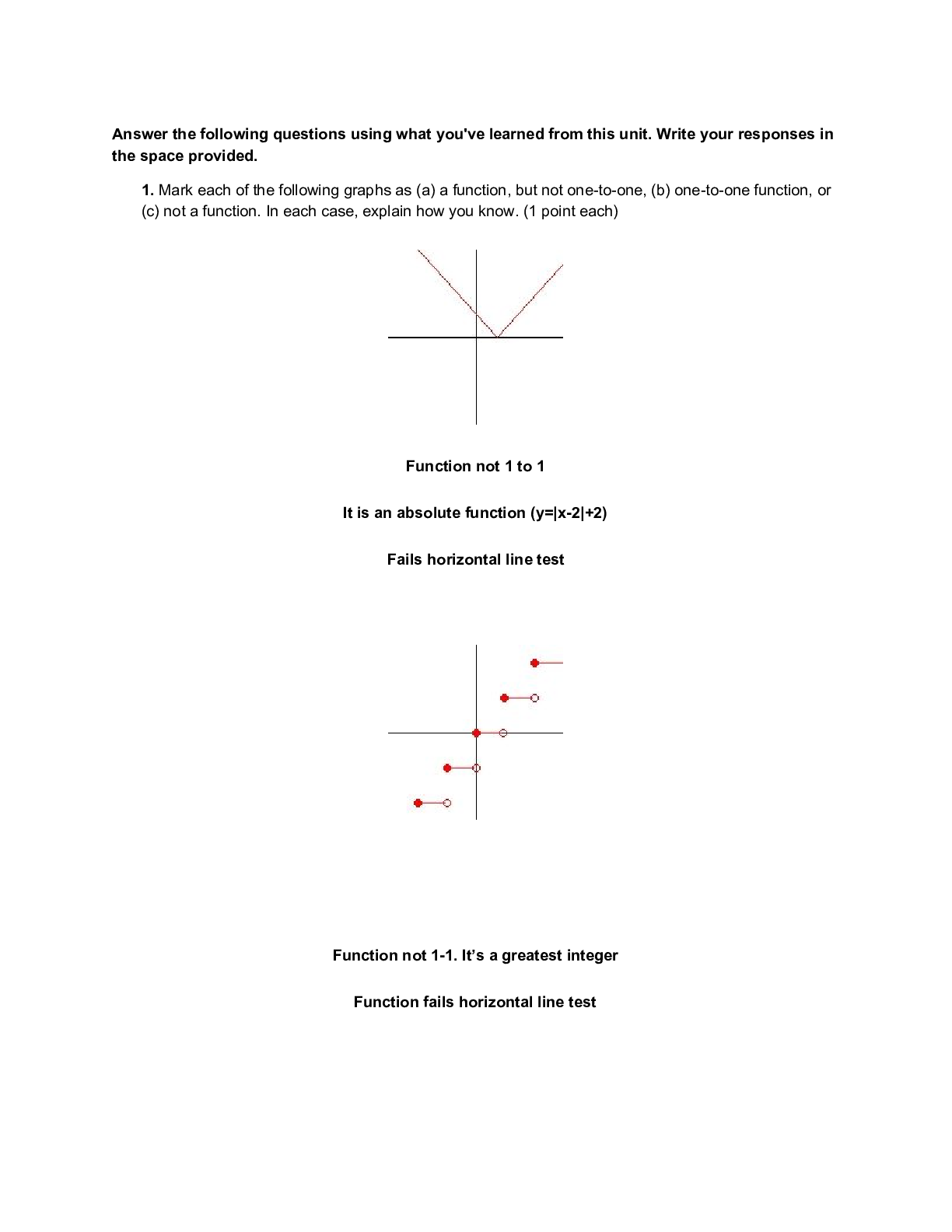











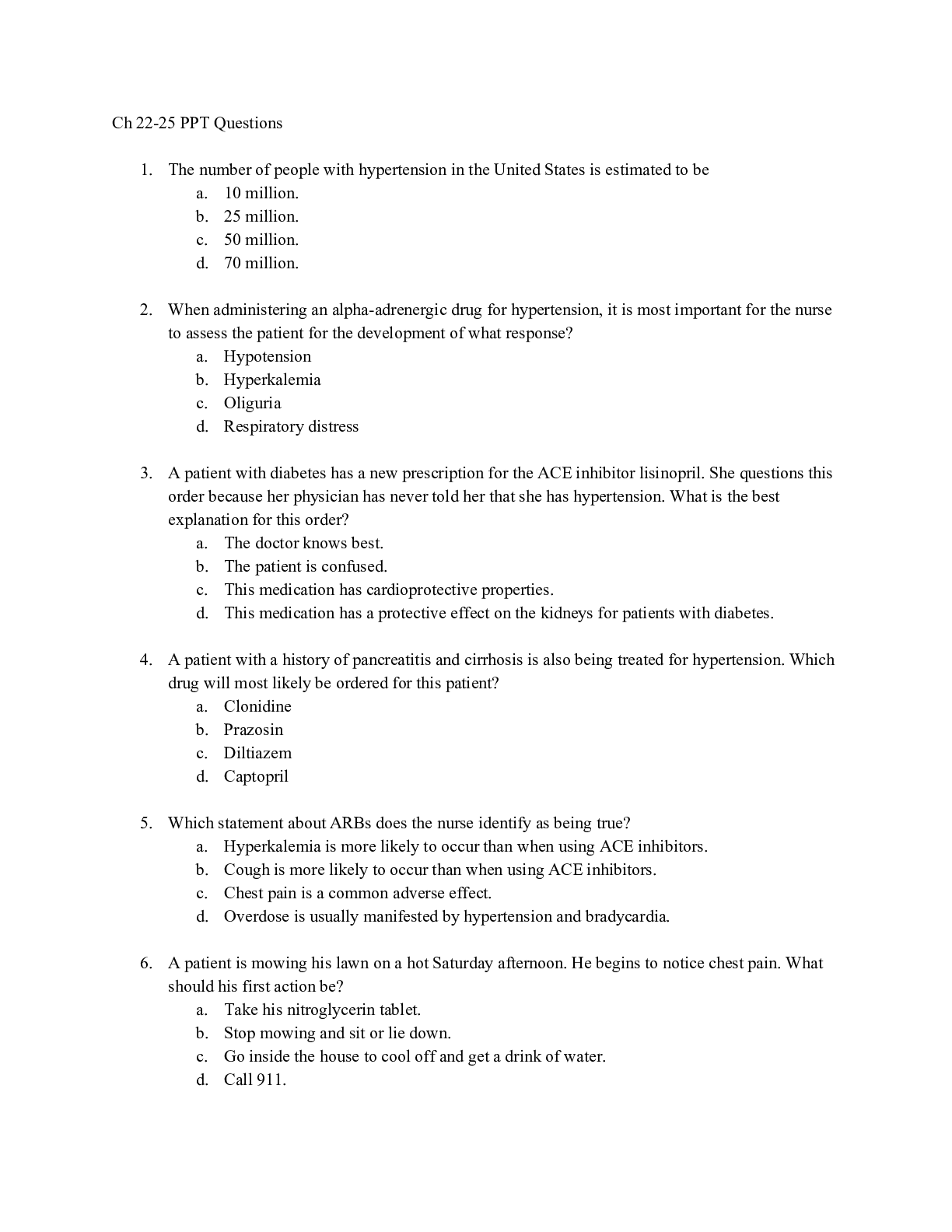
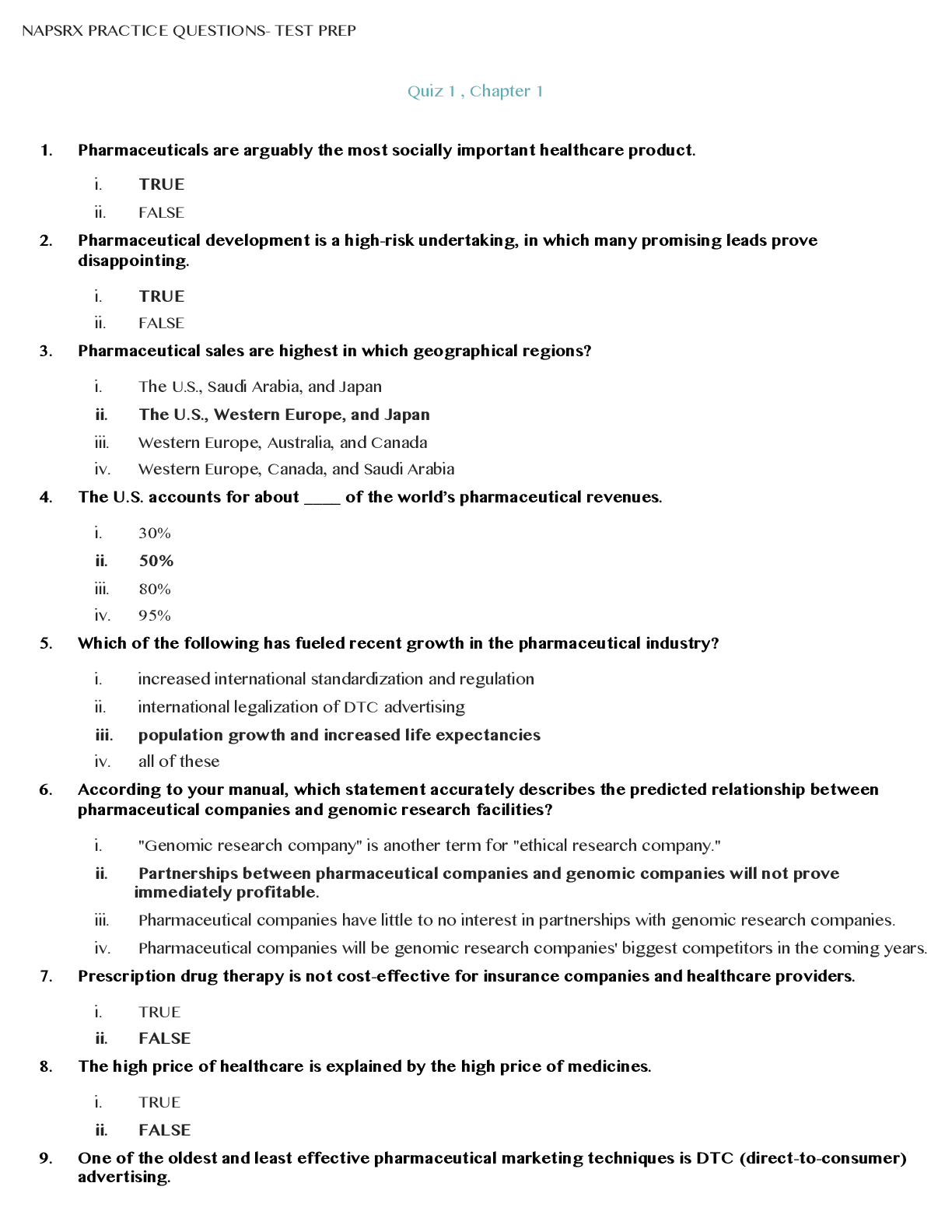
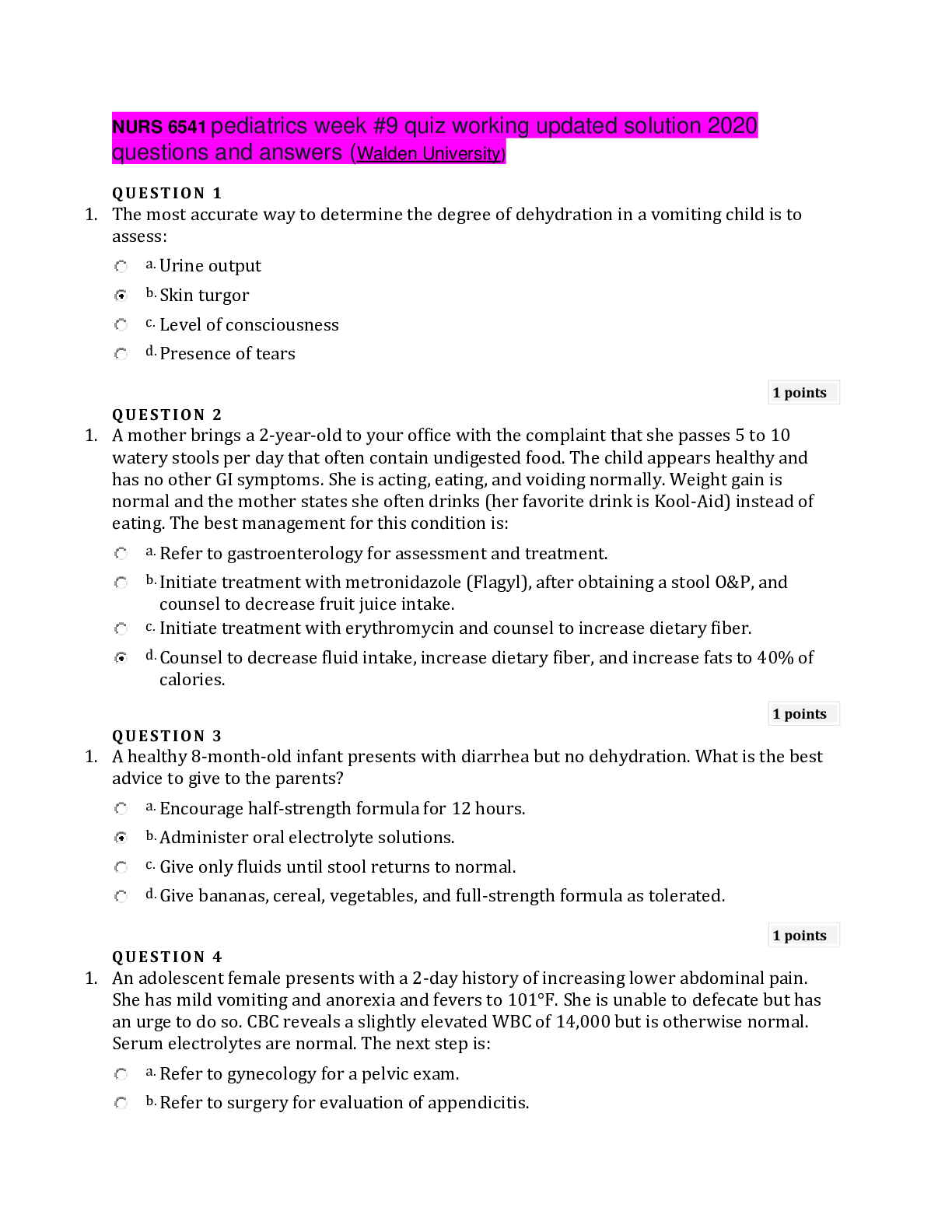
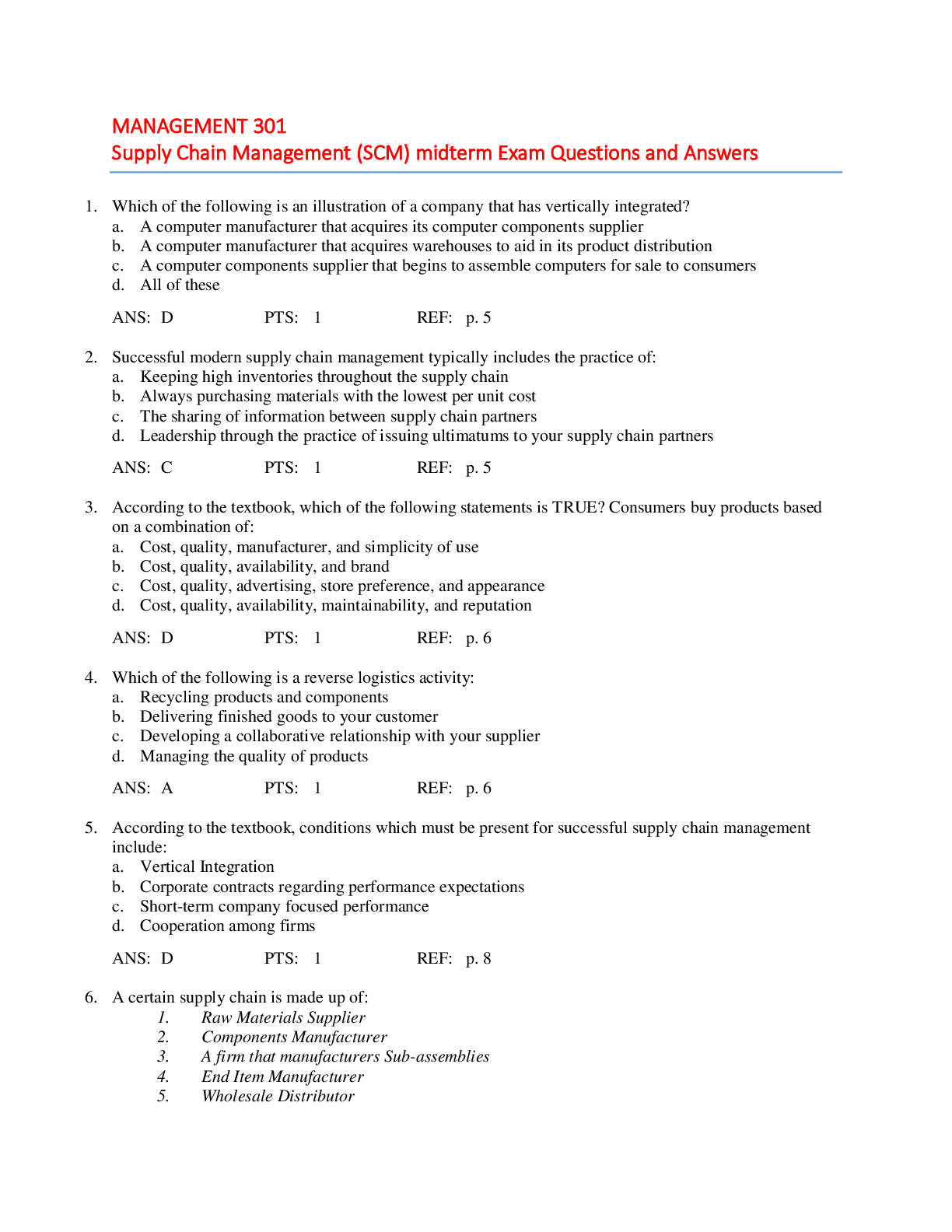
.png)
